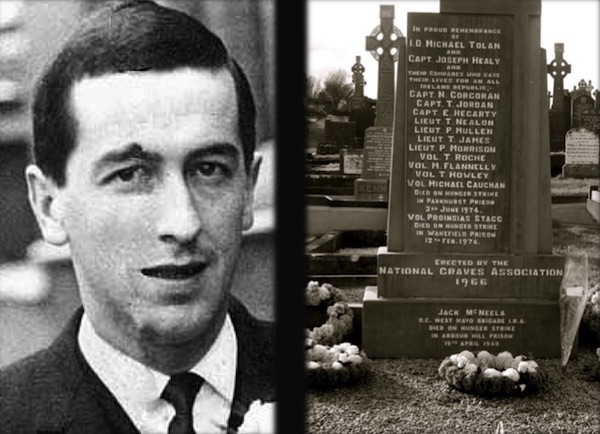
On February 14, 1981, Frank Stagg, an Irish Republican prisoner, died after 62 days on hunger strike in Wakefield Prison, England. His death was part of a long tradition of hunger strikes used as a weapon by Irish republicans against British rule. But Stagg’s legacy is not just one of sacrifice—it is also one of betrayal, defiance, and political maneuvering. His funeral became one of the most controversial in Irish history, a battle over the body of a man who had already given his life for the cause.
Origins: Where Was Frank Stagg From?
Frank Stagg was born in Hollymount, County Mayo, in 1942, into a devoutly nationalist family. Like many young men from his background, he became deeply involved in Irish republicanism, viewing British rule in Northern Ireland as an ongoing injustice.
In the 1960s, Stagg emigrated to England for work, but instead of settling into the life of an ordinary Irish laborer abroad, he joined the Provisional IRA. He became part of the republican struggle, participating in the IRA’s England campaign, which targeted British infrastructure and government institutions to draw attention to the ongoing conflict in the North.
His involvement led to his arrest in 1973, and he was sentenced to 10 years in Wakefield Prison, one of Britain’s highest-security facilities. It was there that he began his final and fatal hunger strike.
The Hunger Strike: A Fight for Political Status
Like other Irish republican prisoners before him, Stagg demanded to be recognized as a political prisoner rather than a common criminal. The British government, led by Prime Minister Harold Wilson, refused to grant this status, insisting that IRA prisoners were ordinary criminals rather than combatants in a political conflict.
In December 1980, Stagg embarked on a hunger strike to protest the conditions of his imprisonment. Inspired by the earlier hunger strike of Michael Gaughan, another Irish prisoner who had died in 1974 under similar circumstances, Stagg refused food for 62 days. His physical condition deteriorated rapidly, but the British authorities remained unmoved.
On February 14, 1981, he died. His death came just weeks before the infamous 1981 hunger strike in Northern Ireland’s Maze Prison, where Bobby Sands and nine other men would also die, further igniting the conflict.
The Three Funerals of Frank Stagg
Stagg’s story did not end with his death. What followed was one of the most dramatic and contested burials in Irish history. His funeral became a symbolic struggle between the Irish government, which sought to suppress militant republicanism, and the IRA, which wanted to honor him as a martyr.
First Funeral – The Dublin Airport Betrayal
After his death, Stagg’s remains were flown back to Ireland. His family and republican supporters planned for him to be buried with full IRA honors in the Republican Plot at Leigue Cemetery, Ballina, County Mayo, alongside Michael Gaughan. However, the Irish government, led by Liam Cosgrave and Justice Minister Paddy Cooney, feared that his burial would become a massive show of support for the IRA.
In a midnight operation, the government intercepted Stagg’s body upon arrival at Dublin Airport. They had already decided that he would not be buried in the Republican Plot.
Second Funeral – The State-Imposed Burial
Instead of allowing republicans to conduct the burial, the Irish government arranged for Stagg’s body to be taken to Ballina in secret. Gardaí (Irish police) escorted the hearse under armed guard to Leigue Cemetery. Instead of the Republican Plot, Stagg was buried in a grave selected by the state, encased under heavy concrete slabs to prevent republicans from exhuming and reburying him elsewhere.
This act was seen as a betrayal by republicans, who believed Stagg’s dying wish had been ignored.
Third Funeral – The IRA Reclaims Its Dead
For six years, the concrete and security around Stagg’s grave prevented any further action. But in 1977, the IRA finally took matters into their own hands. In a dramatic and highly organized operation, they exhumed Stagg’s body in the dead of night and reburied him in the Republican Plot next to Michael Gaughan.
This final burial was a clear message to the Irish state—the republican movement would not be silenced, even in death. The grave of Frank Stagg remains a site of pilgrimage for republicans to this day.
Frank Stagg’s Legacy: The Eternal Struggle
Frank Stagg’s death was not the last hunger strike in Irish history, but it was part of the long tradition of self-sacrifice that defined the republican movement. His battle for political status foreshadowed the larger hunger strikes of 1981, which would become one of the most significant moments in the Troubles.
His funeral saga revealed the deep divisions in Irish politics—between those who wanted to move away from violent republicanism and those who saw the struggle as unfinished business. His name, alongside Bobby Sands, Michael Gaughan, and others, remains a powerful symbol of defiance against British rule.
Further Reading on Ireland’s Revolutionaries
For more deep dives into Irish history and the lives of those who fought for its freedom, check out:
- Dolours Price: The Complex Legacy of an IRA Revolutionary
- Say Nothing: A Deep Dive into the Movie and Its Impact
- Freddie Scappaticci: The Dark Heart of the Troubles
- Dominic Mad Dog McGlinchey: The Fearless and Controversial INLA Leader
Conclusion: A Life Given for a Cause
Frank Stagg’s story is not just about one man—it is about the greater struggle for Irish self-determination. Whether viewed as a hero or a misguided radical, there is no denying that his hunger strike was an act of ultimate commitment to his cause. Even in death, his body became a battlefield, fought over by the Irish government and the IRA.
He remains one of the many faces of Ireland’s long fight for independence, a man who gave his life—and whose funeral became a final, defiant act of republicanism.



